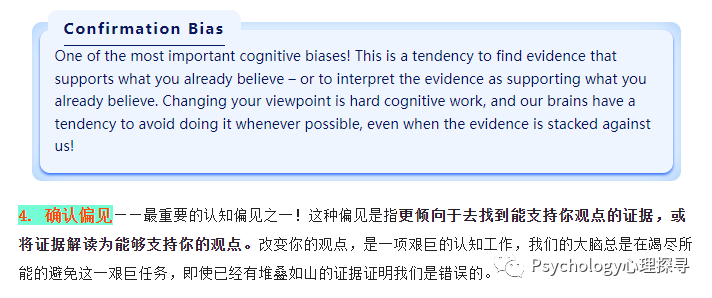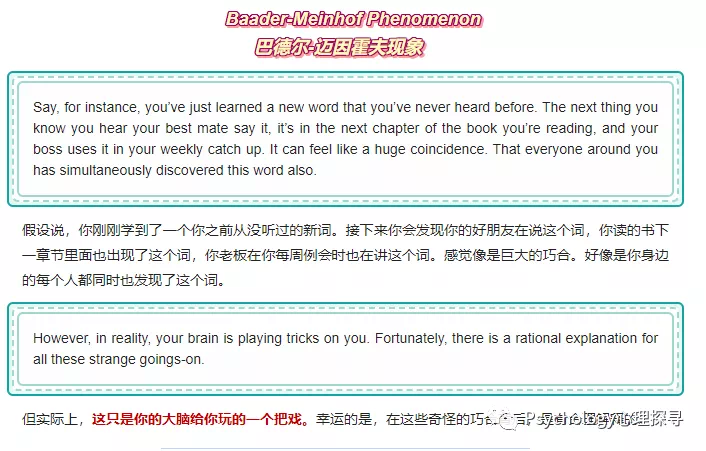Synchronicity | 共时
Synchronicity is a phenomenon in which people interpret two separate—and seemingly unrelated—experiences as being meaningfully intertwined, even though there is no evidence that one led to the other or that the two events are linked in any other causal way. Though many people perceive signs or spiritual meaning in synchronistic events, most scientists believe that such events are more likely coincidences that only seem meaningful due to aspects of human thinking such as confirmation bias.
共时,是指这样一种现象:人们将两个完全独立,或看起来无关的两件事解读为以某种有意义的方式关联在一起,尽管并无证据可以证明二者互为因果或存在其他任何联系。
尽管很多人在共时事件中解读出了某种信号或宗教意义,但大多数科学家却认为这类事件更可能只是纯粹巧合,只不过是因为人类思维的特定方面,比如确认偏见等而看起来富有意义。
Understanding Synchronicity
理解共时
The concept of synchronicity was developed by psychiatrist and psychoanalyst Carl Jung in the early 1900s. Jung himself believed in synchronicity, which he defined as “meaningful coincidences." He wrote extensively about the concept.
共时概念由精神治疗师和心理分析师卡尔·荣格于20世纪初期提出。荣格个人相信“共时”,他将其定义为“富有意义的巧合。”围绕这一概念,他著述颇多。
However, most scientists today consider the idea that coincidences are meaningful to be non-scientific. Instead, many argue that factors such as confirmation bias offer a more compelling explanation: People seek out information to support their ideas and ignore information that challenges them.
但当今的大多数科学家都认为“巧合是富有意义的”这一观点并不科学。他们认为“确认偏见”等因素能够更好地解释这类现象。确认偏见,是指人们会找出那些可以确认自己观点的信息,而忽视那些挑战自己观点的信息。

What is an example of synchronicity?
示例
Synchronicity may be as simple as seeing a word repeatedly and looking for meaning in that experience. In a more complex example, imagine that someone has a dream about an old friend; shortly after, he runs into her. He may believe the events signify something about the friendship, while in reality, they are likely coincidental.
共时,可以是一些简单情形,比如不断看到某个词出现,并在这种巧合中寻找意义。也有较为复杂的情形,比如,一个人梦到了一位老朋友,不久之后就真的碰到了她。他可能认为这传递着关于他们友情的某种信号。但实际上,这可能只是巧合而已。
Who invented the concept of synchronicity?
谁提出了“共时”概念?
Synchronicity was first defined by Carl Jung in the 1920s and explored throughout his career. It has been subsequently studied by physicists such as Wolfgang Pauli, parapsychologists, and some psychoanalysts and Jungian scholars.
这一概念最早由卡尔·荣格于20世纪30年代被定义,对这一概念的研究贯穿他整个职业生涯。之后,也有很多人继续研究这一概念,如Wolfgang Pauli(沃尔夫冈-泡利)等物理学家;一些超心理学家(研究超自然现象或事件的领域)以及一些精神分析师和荣格学派学者等。
Is synchronicity real?
“共时”真实存在吗?
Many modern researchers regard the study of synchronicity as pseudoscience. Synchronistic events can occur randomly, and it may be impossible to scientifically test whether they are, in fact, connected in some meaningful way. What’s more, many instances of synchronicity can be better explained by modern psychological concepts, such as confirmation bias or hindsight bias.
很多现代研究者都将对共时的研究视为伪科学。共时事件会随机发生,而且可能也无法以科学方式测验它们是否的确存在某种有意义的关联。不仅如此,很多共时事件都能够通过现代心理学概念得到更好的解释:比如确认偏见和后见之名偏见等。

What is the difference between coincidence and synchronicity?
巧合与共时,二者有何区别?
Coincidence and synchronicity are related but distinct terms. The term “coincidence” describes a seemingly related series of events that occur without apparent cause. The term “synchronicity” requires that the individual ascribe deeper meaning to the coincidence; indeed, Carl Jung described synchronicity as “meaningful coincidences.”
巧合和共时,二者虽有关联但并不相同。巧合,是指看起来相关联但却没有明显缘由而发生的一系列事件。共时,则需要人为巧合事件赋予更深层意义。卡尔-荣格将共时描述为“富有意义的巧合”。
Are coincidences common?
巧合是否普遍?
In general, yes—particularly because human brains can find “coincidences” in almost anything. Though it’s often not possible to test how likely a particular coincidence is, certain coincidences—like meeting someone with the same birthday—have a measurable probability. A statistical adage known as The Law of Very Large Numbers suggests that in a big enough sample, any so-called “coincidence” is likely to occur.
整体而言,是的,特别是因为人类大脑几乎能够在任何事物中寻找到“巧合”。尽管通常并不可能测验某一特定巧合的发生概率,但某些特定巧合,比如遇到一个同生日之人,却的确是存在可测量的概率的。根据一个被称为“大数定律/法则”的统计学定理,在一个足够大的样本中,任何被称为“巧合”的事件都是有可能发生的。
Why Humans Seek Meaningful Patterns
为何人类会寻找有意义的规律?
It can be easy to spot patterns that don’t truly exist. Why are people so susceptible to this tendency? Experts theorize that, from an evolutionary perspective, pattern recognition was likely beneficial for survival: Ancient human ancestors learned to predict possible threats. For instance, they might realize that predators appear at a particular time of day, so it’s safest to stay hidden.
我们很容易会无中生有地去发现“规律”。为什么人们如此易于有这种倾向呢?专家给出的理论是,从进化论角度来看,识别规律是有益于生存的:古人类祖先学会了预测潜在威胁。例如,他们可能会意识到狩猎者在一天中特定时段出现,这样这段时间里最安全的做法就是藏起来。
Humans impose structure and meaning on their lives. If they come across two events that seem related, they might categorize them together, even if there’s no objective relationship between the two.
人类也会为生活赋予结构和意义。如果他们遇到两个看起来相关联的事件,他们可能就会将其归为一类,即使二者之间并无客观联系。
Why do I see patterns in everything?
为什么我在任何事物中都能看到规律?
The human brain is designed to identify patterns. While this tendency can be useful, it may lead someone to over-interpret a random occurrence or perceive a pattern where none exists. Individuals vary in their tendency to recognize patterns; those who ascribe greater significance to patterns may be more likely to notice them.
人类大脑天生就具有识别规律的能力。尽管这一倾向会很有用,但可能会让人过度解读某一随机现象或无中生有地寻找规律。个体之间规律识别能力各不相同,更重视规律之人可能会更易于注意到规律。

Why do I see the same word or number everywhere?
为什么我到处都看到相同的词或数字?
Feeling that one is seeing the same word or number in multiple places could be the result of confirmation or hindsight bias. Although different words and numbers have different probabilities of appearing—meaning that some repeated sightings are statistically less likely than others—ascribing meaning to such coincidences is an example of synchronicity.
感到在多个地方都看到相同的词或数字,可能是因为确认偏见或后见之明偏见。尽管不同的词和数字有着不同的出现概率——这意味着从统计学上来讲,一些词或数字重复出现的概率要低于其他数字——为这些巧合赋予意义,也是“共时性”的例子之一。
Is pattern recognition a sign of intelligence?
识别规律是智力的一种表现吗?
Excellent visual or logical pattern recognition skills are strongly correlated with high cognitive ability. For this reason, test of pattern recognition are included in most IQ tests. However, excessive pattern recognition—seeing patterns where none actually exist—may be an indicator of certain mental health conditions, such as psychosis.
出色的视觉或逻辑规律识别技能与高水平认知能力密切相关,因此,在大多数智力测试中都包含规律识别测试。但过度识别规律——以至于无中生有——可能意味着某种精神健康疾病,如神经症等。
Are coincidences a sign?
巧合是一种信号吗?
Spiritual individuals may interpret coincidences as signs from God or the universe. However, there is no way to scientifically test these beliefs. While seeing coincidences as signs can provide a sense of purpose, following them too closely can lead to ignoring critical evidence. It’s best to weigh common sense, intuition, and verifiable facts when interpreting coincidences.
信奉某种宗教的人可能会将巧合视为来自上帝或宇宙的信号。但对此并无法从科学方面予以测试。尽管将巧合视为信号,可以给人一种目标感。但过度信奉它们可能会让人对关键证据视若无睹。在解读巧合时最好也衡量常识、直觉和可核实的事实等因素。